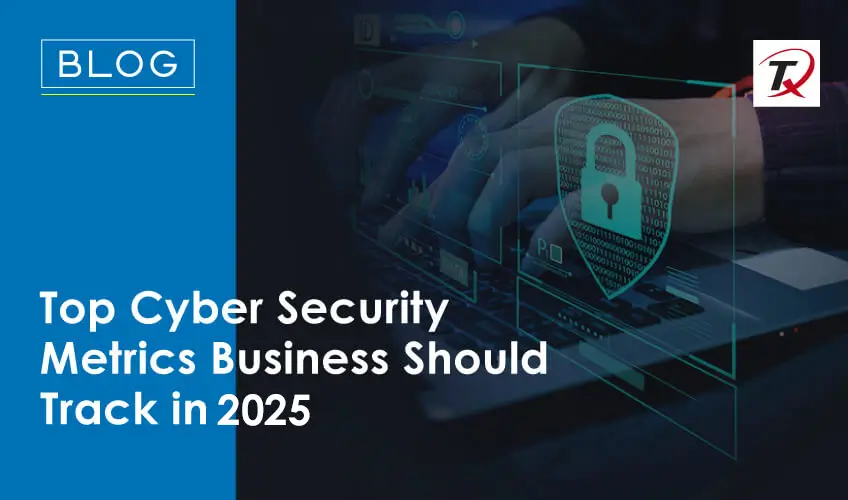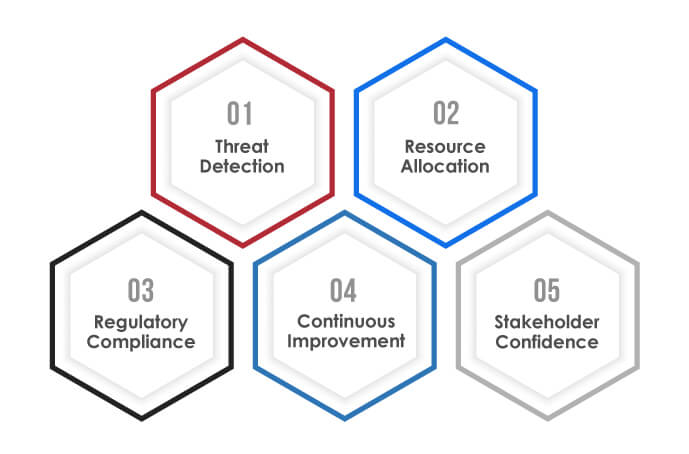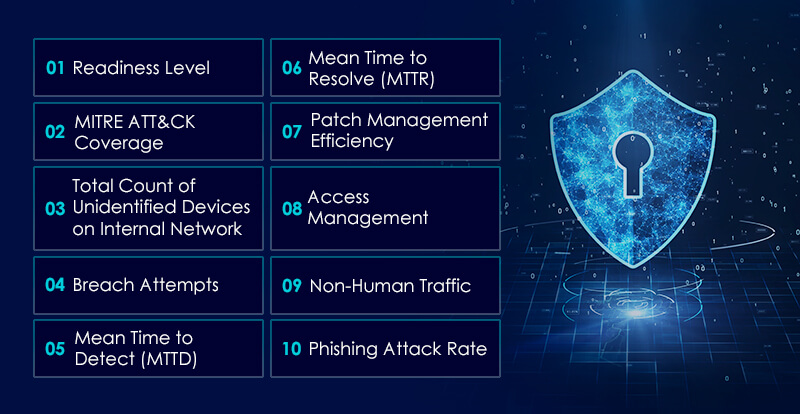Recommended Blogs
Top Cyber Security Metrics Business Should Track in 2025

In today’s digital business environment, when it comes to preventing security breaches, identifying cyber-attacks, and protecting data, there must be a checklist to keep track of cybersecurity efforts. And what would be the best way to do so? The answer is Key Performance Indicators (KPIs). They offer an effective way to measure the success rate of security strategies and aid in decision-making. But why should businesses focus on cyber security metrics? They convert complex security data into actionable insights.
Without security metrics, businesses will be practically blind to emerging threats and vulnerabilities. According to the Cybersecurity Ventures report, cybercrime will cost around $10.5 trillion annually by 2025, highlighting the urgent need for continuous monitoring and adaptation. Edwards Deming states, “Without data, you’re just another person with an opinion.” This is why KPIs, and security metrics are crucial in justifying the value of cybersecurity efforts.
An Overview of Cyber Security Metrics
Cyber security metrics are critical for evaluating the effectiveness of cyber defenses. The KPIs and metrics provide insights into threat patterns, system vulnerabilities, incident responses, and tracking mechanisms, in which AI-driven analytics is also crucial. Organizations can draft better security strategies and allocate resources more efficiently by monitoring security metrics. These metrics keep stakeholders informed about the proficiency of their cyber security protocols, assuring better ROI and the robustness of security measures.
As digital dependency increases, these metrics are necessary for strategic decision-making to standardize business resilience against evolving cyber threats. Cyber security metrics reflect the organization’s adaptability and readiness in the digital threat environment, highlighting the necessity of tracking and improving cyber security strategies.
Importance of Cyber Security Metrics

Things that are not measurable can’t be managed. As cyber threats constantly evolve due to new tech innovations, they become harder to detect. This is why businesses need to have proper measures in place to analyze the effectiveness of their cyber security programs. The metrics allow companies to access vulnerabilities, track performance improvement, and justify security investments. Let’s take a look at some of the factors highlighting the importance of cyber security metrics:
Threat Detection:
Businesses can detect possible security threats before escalating into serious breaches. They can identify and mitigate risks by monitoring trends and data patterns.
Resource Allocation:
Effectively using these metrics would allow organizations to allocate security resources more efficiently. It will ensure critical business areas receive the necessary support, thus optimizing security spending.
Regulatory Compliance:
Adhering to regulatory standards is a crucial practice. Security metrics provide businesses with a clear compliance framework, showing security auditors that the business takes regulatory compliance seriously.
Continuous Improvement:
Businesses can improve security measures by regularly reviewing and analyzing these metrics. This ongoing process enables companies to be ready against emerging threats and adapt to the dynamic cyber landscape.
Stakeholder Confidence:
Maintaining cyber security metrics reports can boost the confidence of stakeholders, including customers, business partners, and investors. Showing commitment to security practices will reassure stakeholders regarding sensitive data protection.
Top 10 Security Metrics Businesses Should Keep an Eye On

Knowing which metrics to monitor is crucial for analyzing cybersecurity effectiveness and maintaining security against potential attacks. These metrics are like the eyes and ears of the security team, providing necessary data to prevent breaches and improve system integrity. Below are the top 10 cyber security metrics and KPIs businesses should track and present to the stakeholders, demonstrating their vendor risk management efforts:
Readiness Level:
The readiness or preparedness metric assesses the risk management program’s security posture and overall value. It allows businesses to evaluate the readiness of their cyber security protocols to handle and mitigate threats. The effectiveness of cyber security measures can be measured following the below set of metrics:
• Amount of security incidents identified and prevented within a given period (week, month, quarter, or year).
• Percentage of security incidents prevented by security measures, such as threat intelligence, endpoint protection, and breach detection systems.
• Number of false positives and negatives generated by monitoring tools, and the reduction in these numbers due to continuous improvement in the monitoring process.
• Level of security awareness among employees due to cybersecurity awareness programs.
• Backup frequency, completeness level, and accuracy analysis
• Simulated phishing attack frequency to evaluate phishing attack susceptibility.
• Number of devices on the corporate network running outdated OS or software.
MITRE ATT&CK Coverage:
By following MITRE ATT&CK, businesses can assess their threat detection capabilities and identify areas for improvement. This metric covers several attack techniques that allow businesses to prioritize security measures according to real-world scenarios. They can strengthen threat detection capabilities against evolving cyber-attacks. When assessing MITRE ATT&CK coverage, organizations must consider the following questions:
• Did they map existing detection processes according to MITRE ATT&CK techniques?
• Are they utilizing the MITRE ATT&CK framework to structure their detection protocols?
Total Count of Unidentified Devices on Internal Network:
Companies can gain valuable insights regarding the risk level of critical assets by identifying vulnerabilities in the internal and external accessible systems. By doing so, they can prioritize gap fixing. Businesses can use manual scans, automated assessments, and other security evaluation tools.
This is also one of the key cyber security metrics because the generated results help update security policies, prioritize patch management, and fulfill compliance requirements. In this metric, businesses should take care of the following points:
• Regular updates for device inventory
• Event and logs of respective network devices
• Tools and protocols for network segmentation
• Device authentication measures
Breach Attempts:
Monitoring and categorizing breach attempts is necessary to understand the frequency and impact of cyber breaches that a business faces. One must keep track of all breach attempts to evaluate the effectiveness of cyber security protocols. While doing so, businesses should focus on the following points:
• Document the number of breach attempts made by cybercriminals. This will provide insights into attackers’ focus targets.
• Access how frequently the unauthorized attempts have been made. Is there a pattern between them, or are they sporadic? This will help identify and make proper arrangements for future attacks.
• Identify the sources of the breaching attempts and use that data to reinforce cyber security measures against the attack vectors targeting IT infrastructure.
Mean Time to Detect (MTTD):
This metric calculates the average duration the cyber security team takes to detect a security incident. It allows businesses to assess the responsiveness of security operations. MTTD allows security teams to measure the efficiency and swiftness of the cyber security and threat identification systems. Shorter MTTD means quick detection and faster response to mitigate risks. Businesses can also identify areas requiring improvement in threat detection methodologies. This enhances the security monitoring tool’s capabilities and alert system’s effectiveness.
Mean Time to Resolve (MTTR): This metric helps in answering the following queries:
• The mean response time after identifying a cyber attack.
• Average MTTR for security teams.
• Coordination and management of security incident response, and the resources involved during the process.
• Continuous evaluation and improvement of the incident response process and the metrics used for tracking.
• The average time taken to identify the root cause of security incidents and the measures utilized to ensure a thorough investigation.
• System and data restoration process following a security incident and the roadmap to validate the process effectiveness.
Patch Management Efficiency:
This metric allows companies to measure how quickly they address identified vulnerabilities by measuring the efficiency of their patch management systems. A high patching rate demonstrates a proactive approach to resolving vulnerabilities, reducing attack areas, and minimizing exposure to security incidents. This metric can be easily calculated by dividing the number of patched vulnerabilities by the number of identified vulnerabilities in a given timeframe (usually every month). Measuring the ‘day to patch’ metric would help in answering the following questions:
• How long does the relevant team take to implement security patches?
• How is to implement security patches? metric defined and measured within the organization?
Access Management:
This cyber security metric relates to a business’s controls, processes, and practices to manage user access controls to networks and systems. With this metric, businesses get to know:
• Number of users having admin access.
• The way they manage user access within the networks and systems.
User authentication success rate is the part of access management that evaluates the effectiveness of authentication mechanisms, such as MFA, passwords, biometrics, etc. A high authentication rate demonstrates robust access control, which reduces the chances of unauthorized access.
Non-Human Traffic:
This metric prevents businesses from tracking bot traffic and helps them understand their operations and efforts’ success rate. NHT consists of a portion of network or web traffic originating from automated sources instead of real users. This metric allows businesses to quantify the following questions:
• Have they been experiencing normal traffic on the website, or is there a potential bot attack?
• What is the web traffic percentage that’s categorized as non-human?
Phishing Attack Rate:
Phishing attacks remain the common and frequent vector in the current digital business environment. Monitoring phishing attack rates will allow businesses to evaluate the effectiveness of their training and preventive measures. This metric allows businesses to measure the following:
• Percentage of phishing emails opened by end-users.
• Variations in phishing attacks that were successful.
• Percentage of users who clicked on Phishing links.
• Percentage of users who submitted information on the Phishing Simulation Page.
• The percentage of users mandated to take phishing awareness training and the percentage of users who successfully completed it.
A high click rate on phishing emails will represent the need for proper user training and awareness programs. Businesses must conduct regular training and simulated phishing activities to inform employees, reduce click rates, and strengthen cyber security defenses.
Why Partner with Tx for Cyber Security Testing?
Choosing the right cyber security testing partner is necessary for protecting digital assets. Tx specializes in evaluating a wide range of applications for security threats by analyzing the necessary metrics and the results they provide. Our security auditing and testing approach aligns well with industry standards such as NIST, OWASP, PCI-DSS, HIPAA, WAHH, SOX, etc. Partnering with Tx will give you the following benefits:
• Our team of Highly Certified Security Professionals brings years of expertise to our security testing efforts.
• Our security testing follows international standards to ensure every cybersecurity metric is by respective guidelines and protocols.
• We provide vendor-independent security testing services and possess deep expertise in key cyber security methodologies in banking.
• Our auditing and testing approach ensures zero false positives and provides snapshots of exploitation to validate the severity of vulnerabilities.
• We perform vulnerability and pen testing to safeguard your apps, infrastructure, and systems from cyber threats.
• Our cyber security center of excellence team conducts in-depth pen testing to identify and rectify security gaps before they can be exploited by malicious actors.
Summary
In the dynamic landscape of digital security, the role of cyber security metrics must be addressed. These metrics provide businesses with crucial insights to manage threats, optimize resource allocation, and adhere to regulatory standards. By continuously monitoring and analyzing these KPIs, organizations can effectively detect and mitigate risks and enhance their overall security posture. Partnering with Tx ensures that your cybersecurity measures are comprehensive, up-to-date, and aligned with the best industry practices. With our expertise, your business is better equipped to face the challenges of tomorrow’s cyber threats.
Discover more
Stay Updated
Subscribe for more info
